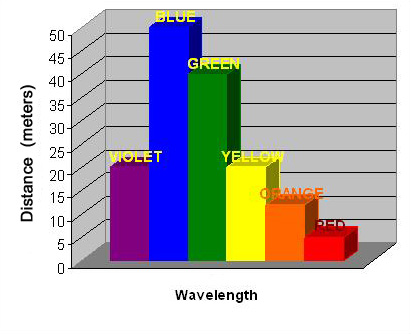
Color loss underwater is due to selective absorption
Visible "white" light is composed of a spectrum of colors: violet, blue, green, yellow, orange, red (given in the order of increasing wavelength). Underwater there is a rapid (exponential) loss of light intensity which depends upon the wavelength of each component. This phenomena is called selective absorption and is due to vibrations and deformations of water molecules excited by the absorption of light. The absorption is strongest at longer wavelengths, the exact values depending upon the water's transparency (sediment, plankton, etc.). Red, the most affected, is reduced to 1/3 of its intensity after a meter and is essentially lost after a distance of 4 or 5 meters underwater. The figure gives an idea of the relative importance for different colors in Mediterranean seawater; the distance for effective "color extinction" is shown versus wavelength. In sunlight, the distance is usually associated with the depth. In artificial lighting, it is defined by the round trip distance between the photographer's flash, the subject and the camera.
Mastering color loss underwater requires using artifical light and working close to the subject
The explanation above should make it clear that using colored filters to “correct color loss” beyond the shallowest depths can not fully recover vivid colors. Mastering this loss is best achieved by placing both the light source and the camera near the subject to reduce the light path. This working condition is one of the reasons for the general use of very wide-angle lenses in underwater photography. Naturally, the angular coverage of the light source should be adapted to the lens choice. Images taken near the subject with one or two flashes give a stunning vision of the underwater world, full of vibrant colors, very different from that perceived by fish...

